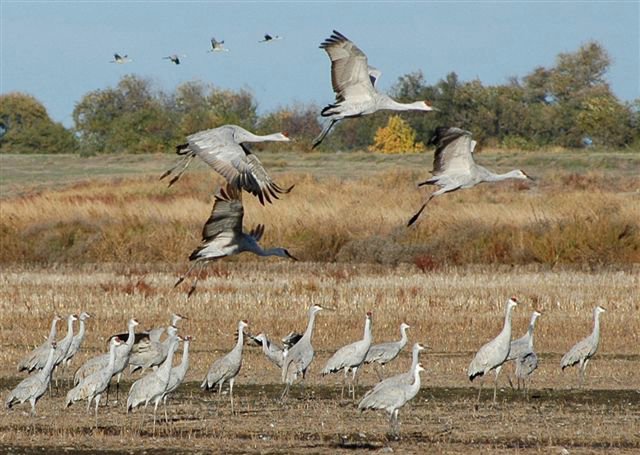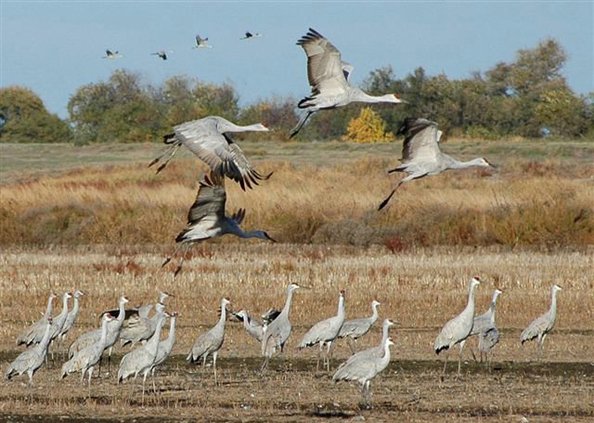LODI — The Lodi Sandhill Crane Festival is returning to Lodi’s Hutchins Street Square on Saturday, Nov. 5, and Sunday, Nov. 6
The event’s popular guided wildlife tours begin Friday, Nov. 4, and are scheduled through Sunday, Nov. 6. Reservations are strongly recommended as tours fill quickly. For a list of tours, including space availability and fees, visit www.lodisandhillcrane.org.
Though a range of wildlife tours are scheduled during the Festival, organizers with the Lodi Sandhill Crane Association (LSCA) want to assure the public that the Sandhill Cranes will be in the Lodi area into February, with many local viewing options.
The spectacular birds can be seen throughout the “season of the crane” at area refuges and many naturalist-led tours are available. Details are available on the LSCA website.
Sandhill Crane Festival activities at Hutchins Street Square - including speakers and presentations, an art show, exhibit hall, silent auction and merchandise sales - are free and open to the public on Saturday and Sunday beginning at 10 a.m.
Featured at this year’s Sandhill Crane Festival is the photography of Garry Everett. His photo of a dancing Sandhill Crane titled “Happy Feet” was selected for 2022 SCF promotional materials including shirts and commemorative posters.
Everett will be sharing more of his work at the Festival.
As part of the annual celebration, the Lodi Sandhill Crane Association is also staging the LSCA Student Art Exhibition throughout the month of November. Students’ work will be displayed at the Lodi Public Library and the Lodi Community Art Center. Both sites will be open from 11 a.m. to 4 p.m., Friday-Sunday of the Festival weekend.
LSCA is a volunteer-run, non-profit membership organization. Those interested in membership or volunteer opportunities are encouraged to visit the LSCA website at www.lodisandhillcrane.org.
Famous for their courtship dance, the Sandhill Crane is one the largest migrating North American cranes according to the Audubon Society. Its wingspan can reach almost seven feet wide and it can be up to four feet tall.
The width of the crane's wings make it a spectacular soaring bird that can be compared to raptors. It uses thermals in the sky to fly and can stay in the air with little flapping. The Sandhill Crane is an incredibly old species, a fossil found was 2.5 million years old, which is over one and a half times older than the earliest remains of most living species of birds.
Sandhill Cranes can be found near large freshwater marshes, prairie ponds, marshy tundra during summer and on grainfields or prairies during migration and in winter. Its range in the Pacific Flyway is from Siberia and Alaska to California's Central Valley. The mating dance of the Sandhill Crane is spectacular. Facing each other, members of a pair leap into the air with wings extended and feet thrown forward. Then they bow to each other and repeat the performance, uttering loud croaking calls. Courting birds also run about with their wings outstretched and toss tufts of grass in the air.
Greater Sandhill Cranes were once common breeders throughout the intermountain west, wintering primarily in the Central Valley of California. However, their populations declined drastically as a result of unregulated hunting and habitat loss during settlement of the region. They became extinct as a breeder in Washington by 1941, when there were only an estimated 150-200 pairs remaining in Oregon. In California, the breeding population was reduced to fewer than five pairs by the 1940s. Fortunately, all populations of Greater Sandhill Cranes have increased since the 1940s, and in 2000 an estimated 465 pairs were breeding in California. Nonetheless, much of their historic range remains vacant and the population remains far below historic numbers.
California in particular is special in that it supports the Central Valley population of Greater Sandhill Cranes that winters in suitable agricultural fields and wetlands of the Central Valley and breeds in northeastern California, as well as parts of Nevada, Oregon, Washington, and British Columbia, mostly on private lands. The Central Valley population of Greater Sandhill Cranes remains low, with recovery of the population hindered by the lack of directed conservation, despite the potential for habitat restoration and farmland management that could greatly benefit this population.





